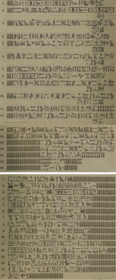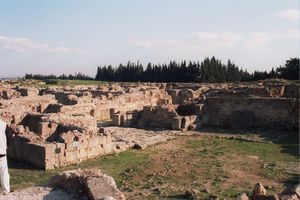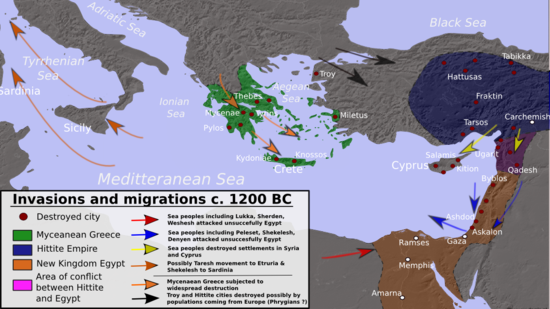شعوب البحر
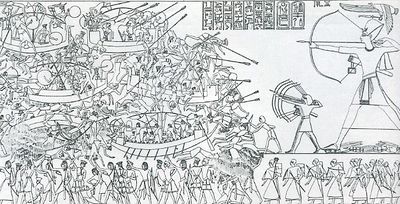
| |||||||||
| شعوب البحر (n3 ḫ3s.wt n<.t> p3 ym) بالهيروغليفية |
|---|
شعوب البحر Sea Peoples ، هم مجموعة من الشعوب القديمة التي هاجرت عن طريق البحر المتوسط وهاجمت الممالك الواقعة شرقي حوض المتوسط، وكذلك مصر في فترة حكم الأسرتين التاسعة عشر والعشرين، والحيثيون في الأناضول. أدت هجمات شعوب البحر إلى سقوط الإمبراطورية الحيثية وإضعاف المملكة المصرية الفرعونية لمدة طويلة، وتدمير العديد من مدن شرق المتوسط العامرة كأوغاريت مثلاً.
تاريخ المفهوم
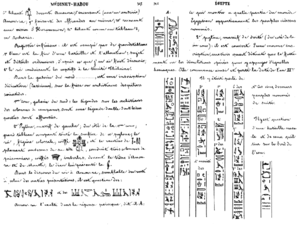
المصطلح "شعوب البحر" استخدمه لأول مرة إمانوِل دى روجيه في 1855، وكان حينها أمين متحف اللوڤر، حين لاحظ "في دروع الشعوب المهزومة، من شردن و ترش يوجد وسم 'peuples de la mer'".[3] de Rouge's work was based upon recent photographs of the inscriptions by John Beasley Greene.[4][5][6] De Rougé later became chair of Egyptology at the Collège de France, and was succeeded by Gaston Maspero. Maspero built upon de Rougé's work, and published The Struggle of the Nations,[7] in which he described the theory of the seaborne migrations in detail for a popular audience in 1896, at a time when the idea of population migrations would have felt familiar.[8]
The theory was taken up by other scholars such as Eduard Meyer, and became the generally accepted theory amongst Egyptologists and orientalists.[9]
Since the early 1990s, the theory has been brought into question by a number of scholars.[10][11][12]
The historical narrative stems primarily from seven Ancient Egyptian sources,[13] and although in these inscriptions the designation "of the sea" appears in relation to only three groups of people (the Sherden, Shekelesh, and Eqwesh),[14][11][15] the term "Sea Peoples" is commonly used to refer to the following nine peoples, in alphabetical order:[16][17]
| Egyptian name | Original identification | Other theories | |||||
|---|---|---|---|---|---|---|---|
| People | Trans- literation |
Year | Author | Theory | |||
| دنين | d3jnjw | 1872 | Chabas[18] | Greek Danaoi[19] | Israelite tribe of Dan[19] | ||
| إقوِش | jḳ3w3š3 | 1867 | de Rougé[18] | Greeks (Achaeans)[20][19][21] | |||
| لوكـّا | rkw | 1867 | de Rougé[18] | Lycians;[21][20] | |||
| Peleset | prwsṯ | 1855 | de Rougé[22][23] | Philistines | |||
| 1872 | Chabas[24][25] | Pelasgians | |||||
| Shekelesh | š3krš3 | 1867 | de Rougé[18] | Siculi[21][20] | |||
| Sherden | š3rdn | 1867 | de Rougé[18] | Sardinians[20][21][26][27] | |||
| Teresh | twrš3 | 1867 | de Rougé[18] | Tyrrhenians[20][21][28] | |||
| Tjeker | ṯ3k3r | 1872 | Chabas[18] | Teucrians[29] | |||
| Weshesh | w3š3š3 | 1872 | Chabas[18] | Oscans[18] | Considered to remain unidentified[24] | ||
السياق التاريخي
تعرضت مناطق شرقي البحر المتوسط، ولاسيما سوريا والساحل الفينيقي ووادي النيل، في نهاية القرن الثالث عشر وبداية القرن الثاني عشر قبل الميلاد، لهجمات من قبائل مختلفة يعتقد أن غالبيتها كانت هندو-أوربية Indo-European، قدمت من مناطق أرخبيل بحر إيجة والبلقان، وربما من جزيرة قبرص واليونان أيضاً، حسب المعطيات الأثرية الحديثة. ويبدو أن هذه القبائل أو ما سمي فيما بعد شعوب البحر The Sea Peoples، لم يكونوا بمجملهم قراصنة يبتغون الاستيلاء على المناطق الخصبة، وإنما كان منهم أقوام مهاجرون، أُجبروا على ترك أراضيهم، تحت ضغط قبائل أخرى، وهذا ما حصل لقبائل الآخيين Achaeans الذين اضطروا إلى الرحيل عن أرضهم، نتيجة استيلاء الدوريين القادمين من البلقان عليها. وكان بين شعوب البحر قبائل وشعوب أصابها القحط، فهاجرت إلى مناطق شرقي المتوسط ولاسيما سوريا ومصر.[30]
لم تَفِدْ شعوب البحر إلى المنطقة دفعة واحدة، بل كانت هجماتهم على مراحل، وعلى امتداد ثلاثة قرون من الزمن، ومن تلك الشعوب الفريجيون Phrygians، والليسيون المعروفون باسم Ekwesh، والفلستيون (البلست) Peleset والتجكر Tjekker والشاكلاش Shekelesh والشردانيون Sherden واللوكيون Lukka وغيرهم.
وردت بعض أسماء قبائل شعوب البحر في وثائق فراعنة مصر، وملوك الدولة الحثية منذ القرن الرابع عشر قبل الميلاد، حيث كانت تصل أفواج منهم إلى مصر للعمل كمرتزقة في الجيش المصري كالشردانيين، أو في صفوف الدويلات السورية الموالية لمصر ضد الدولة الحثية مثل قبائل الدانونة Denyen والشاكلاش واللوكيين، وكانت قبائل منهم تنزل في منطقة الأناضول وتؤازر الدولة الحثية في حروبها ضد الامبراطورية المصرية، مثل البداسا Baddassa والدرداني Dardani والماسا Massa والكرانيشا Kranisha والإرونيتا Eronita وغيرها من القبائل.
وصل القسم الأول من هذه القبائل من البلقان، وهو من الفريجيين والماسا، إلى سواحل آسيا الصغرى، واتحدوا مع قبائل الكازكاز Kazkaz، أعداء الحثيين، الذين كانوا يقطنون في المناطق الشمالية من آسيا الصغرى، ولاسيما السواحل الجنوبية من البحر الأسود وبحر مرمرة، وتحركوا نحو العاصمة الحثية حاتوشا، وعملوا على إحراقها وتدميرها، عام 1200ق.م تقريباً، رغم تحرك فرعون مصر «مرنپتاح» لمساعدتها، ورغم مؤازرة المدن الموالية لها كاوغاريت. وبعد تدميرهم للدولة الحثية تابع الغزاة سيرهم فدمروا كركميش (جرابلس)، وجعلوا قاعدتهم في أمورو.
أما القسم الثاني من القبائل المغيرة، فقد اتجه بسفنه من كريت إلى قبرص فدمرها وأجبر حكامها على الانضمام إليه، ثم تابع مسيره إلى اوغاريت حيث دمرها، واتجه إلى أرواد فجعلها قاعدة له للهجوم على الساحل السوري كله.
السجلات الوثائقية الرئيسية
Whilst the Medinet Habu inscriptions from which the Sea Peoples concept was first described remain the primary source and "the basis of virtually all significant discussions of them",[31] there are three primary narratives from Egyptian records which refer to more than one of the nine peoples, found in six sources. A seventh source referring to more than one of the nine peoples is a list (Onomasticon) of 610 entities, rather than a narrative:[13]
| Date | Narrative | Source(s) | Peoples named |
|---|---|---|---|
| c. 1210 BCE | Ramesses II narrative | Kadesh Inscriptions | Karkisha, Lukka, Sherden |
| c. 1200 BCE | Merneptah narrative | Great Karnak Inscription | Eqwesh, Lukka, Shekelesh, Sherden, Teresh |
| Athribis Stele | Eqwesh, Shekelesh, Sherden, Teresh | ||
| c. 1150 BCE | Ramesses III narrative | Medinet Habu | Denyen, Peleset, Shekelesh, Sherden, Teresh, Tjekker, Weshesh |
| Papyrus Harris I | Denyen, Peleset, Sherden, Tjekker, Weshesh | ||
| Rhetorical Stela | Peleset, Teresh | ||
| c. 1100 BCE | List (no narrative) | Onomasticon of Amenope | Denyen, Lukka, Peleset, Sherden, Tjekker |
Other Egyptian sources refer to one of the individual groups without reference to any of the other groups:[13] the Amarna letters (EA 151 refers to the Denyen, EA 38 to the Lukka, and EA 81, EA 122 and EA 133 to the Sherden), Padiiset's Statue refers to the Peleset, the Cairo Column[32] refers to the Shekelesh, the Story of Wenamun refers to the Tjekker, and 13 further Egyptian sources refer to the Sherden.[33]
عهد رمسيس الثاني
عهد مرنپتاح
| |||||||||
| "من البحر" في نقش الكرنك العظيم، في إشارة إلى شعوب إقوِش و شكلش و شردن (n3 ḫ3s.wt n<.t> p3 ym) بالهيروغليفية |
|---|

بدأت هجمات شعوب البحر على مصر منذ عهد الفرعون «مرنپتاح» (1236-1223ق.م)، الذي واجه تحالفاً ضم شعوب البحر مع الليبيين، إلا أن «مرنبتاح» استطاع صدَّهم، وهَزَمَهم وقتل وأسر الكثير منهم.
سجلات وثائقية أخرى
فترة العمارنة المبكرة
مسلة جبيل
رسائل في اوگاريت
حكم رمسيس الثالث
تجددت هجمات شعوب البحر في عهد الفرعون رعمسيس الثالث (1198-1166 ق.م.)، حيث قاموا بعدة حملات على مصر، كان أولها في السنة الخامسة من حكمه، حين شنت شعوب البحر مع حلفائهم الليبيين هجوماً كبيراً على حدود الدلتا الغربية، وحاولوا الوصول إلى مدينة منف، فاستطاع رعمسيس صدهم، وهزمهم هزيمة منكرة، وأعادوا الكرة في السنة الثامنة من حكمه، ولكنه استطاع سحقهم، وتمكن من استئصال شأفتهم وإبعاد خطرهم بشكل نهائي عن مصر وغربي آسيا، وقد سجل تفصيلات انتصاراته على جدران معبده في مدينة هابو الواقعة على البر الغربي للعاصمة طيبة.
كانت آخر حملاتهم على مصر في السنة الحادية عشرة من حكم رعمسيسس الثالث، حيث قامت قبائل المشواش Meshwesh القاطنة في الصحراء، غربي أراضي ليبيا، بهجوم من جهة الدلتا مع حلفائهم الليبيين، واستطاع الحلفاء الاستيلاء على المنطقة الواقعة إلى الغرب من الدلتا، ووصلوا إلى فرع النيل الغربي، إلا أن رعمسيس صدَّهم وانتصر عليهم مرة أخرى.
لا يوجد أرض ممكن أن تصمد أمام أسلحتهم

التحقق من الهجوم
الناجون
فرضيات حول شعوب البحر
الفرضية الفلستينية
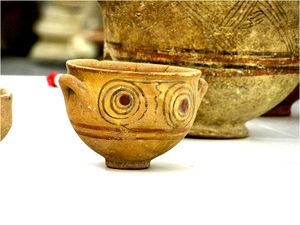
استقرت بعض قبائل شعوب البحر في نواحي البحر المتوسط، فقبائل البلست، التي جاءت من كريت، أو قبرص حسب الدلائل الأثرية الحديثة، استقرت على ساحل فلسطين الجنوبي الممتد من دور إلى غزة، ثم انضم البلست إلى الكنعانيين والعموريين سكان المنطقة الأصليين وانصهروا فيهم وعبدوا إلههم (دجن)، ومع مرور الوقت أخذت المنطقة اسمهم وأصبحت تدعى فلسطين، وهم الذين أدخلوا معدن الحديد إلى المنطقة.
الفرضية المنيوية
فرضية الهجرة اليونانية
فرضية طروادة
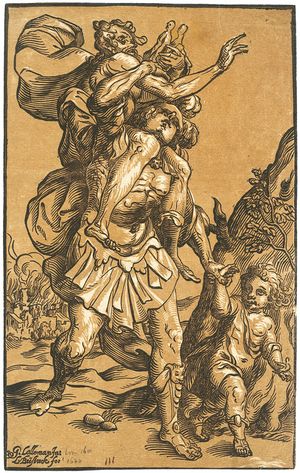
فرضية الحرب المسينية
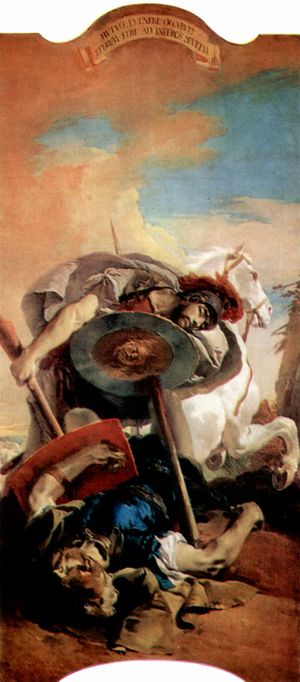
فرضيات الشعوب الإيطالية
أما الشردان فقد توجهوا إلى جزيرة سردينيا واستوطنوا فيها وأعطوها اسمهم، وكذلك الأمر بالنسبة لقبائل الشكلاش الذين استقروا في صقلية وسميت باسمهم، بينما ذهب الأتروسكيون Etruscans إلى شبه الجزيرة الإيطالية وأسسوا عدداً من دول المدن في القسم الشمالي الوسيط منها.
فرضية مجاعة الأناضول
فرضية الغازي
كان لغزوات شعوب البحر نتائج مهمة ومؤثرة على مناطق المشرق العربي القديم، ومن أهمها القضاء على إحدى أعظم امبراطوريات ذلك العصر، وهي الدولة الحثية، ودمار بعض المدن الفينيقية التي كان لها دور مؤثر في المنطقة، مثل كركميش وصيدا وصور، واوغاريت التي اختفت من خارطة التاريخ، بينما نهضت مدينتا صيدا وصور من جديد. ويظهر من البقايا الأثرية أن بعض قبائل شعوب البحر قد استقر في موقع ابن هانئ التابعة لاوغاريت على الساحل السوري. لقد استطاعت مصر صد الهجمات التي توجهت إلى أراضيها، لكنها خسرت أراضيها في سورية والساحل الفينيقي، واضطرت إلى التراجع والانكماش في وادي النيل.
مستنقع سربون
الهوامش
- ^ انظر أيضاً الاسكتش المعطى للجانب الأيسر من العمود: Champollion, Monuments, Plate CCVIII
- ^ Compare with the hieroglyphs provided by the Woudhuizen thesis on p.36.
- ^ خطأ استشهاد: وسم
<ref>غير صحيح؛ لا نص تم توفيره للمراجع المسماةdeRouge - ^ de Rougé 1855, p. 1.
- ^ Greene 1855, p. 4: [Original French]: "Les notices et la XVIII° lettre de Champollion donnent un résumé très-complet et très-fidèle des campagnes de Ramsès III (son Ramsès Meiamoun), surtout de celle représentée sur le mur du nord, où se trouve le célèbre bas-relief d'un combat naval dans lequel les vaisseaux ennemis sont acculés au rivage par la flotte égyptienne, et en même temps écrasés par l'armée de terre qui les presse de l'autre côté.
Champollion a reconnu que, parmi les ennemis de Ramsès, se trouvaient des peuples nouveaux, appartenant à la race blanche, et désignés sous le nom de Tamhou. Il n'a copié que la première ligne de la grande inscription du pylône, où se trouve indiquée une date de la neuvième année du roi, et il a signalé l'importance de ce texte, qui contient plusieurs noms de peuples....
Après avoir reçu ce juste tribut de louanges, le roi commence enfin son discours à la ligne treizième. Il recommande à tous ses sujets d'être attentifs à ses paroles, et leur indique les sentiments qui doivent les diriger dans la vie; puis, il se vante de ses exploits, dont il rapporte cependant la gloire à son père, le dieu Ammon, qui lui a donné toutes les conquêtes. Après une tête de colonne qui malheureusement a beaucoup souffert, vient un des passages les plus importants de notre texte, dans lequel le roi énumère les ennemis qu'il a vaincus, en commençant par les Chéta, les Ati, les Karkamasch, les Aratou, les Arasa ; puis, après une courte interruption : leur camp ensemble dans le pays d' Amaour, j'ai détruit ces peuples et leur pays comme s'ils n'avaient jamais existé.
On voit que ces différents peuples, ennemis ordinaires des rois d'Égypte dans leurs campagnes d'Asie antérieures à celles de Ramsès III, sont réunis dans un seul groupe. A la colonne suivante, nous trouvons un second groupe formé des peuples désignés par Champollion comme ayant joué un rôle important dans la campagne pendant laquelle s'est livré le combat naval; ce sont les Poursata, les Takkara , les Shakarsha, les Taamou et les Ouaschascha. On voit que les Sharetana manquent seuls à cette énumération."
[Translation]: "The notices and the XVIII° letter of Champollion provide a complete and faithful summary of the campaigns of Ramses III (his Ramses Ammon), especially that represented on the north wall, containing the famous bas-relief of a naval battle where the enemy ships are driven to shore by the Egyptian fleet, and simultaneously crushed by the army, which the press on the other side.
Champollion recognized that among the enemies of Ramses, there were a new people, belonging to the white race, and designated as the Tamhou. He copied the first line of the large inscription of the pylon, with a date he specified in the ninth year of the reign, and he noted the importance of this text, which contains several names of people....
After receiving this just tribute of praise, the King finally begins his speech to the thirteenth line. It recommends to all his subjects to pay attention to his words, and shows their feelings that must lead them in life; then he boasts of his exploits, he brings glory to his father, the god Ammon, who gave him all the conquests. After a column header which unfortunately suffered a lot, is one of the most important parts of our text, in which the king lists the enemies he has overcome, beginning with the Cheta, the Ati, the Karkamasch the Aratou, the Arasa; then, after a short break: at their camp in the country of Amaour, I destroyed the people and their country as if they had never existed
We see that these different peoples, common enemies of Egypt in their Asian campaigns before those of Ramses III, are gathered in one group. In the next column, we find a second group formed of people considered by Champollion to have played an important role in the campaign with the naval combat ships; it is the Poursata, the Takkara, the Shakarsha, the Taamou, and Ouaschascha. We see that the only missing Sharetana to this list." - ^ Greene's documentary photographs are held at the Musee d'Orsay, for example: Médinet-Habou, Temple funéraire de Ramsès III, muraille du nord (5); inventory number: PHO 1986 131 40.
- ^ Maspero 1896, p. 461-470.
- ^ Silberman 1998, p. 270.
- ^ Drews 1992: "In fact, this migration of the Sea Peoples is not to be found in Egyptian inscriptions, but was launched by Gaston Maspero in 1873 [footnote: In the Revue Critique d'Histoire et de Litterature 1873, pp. 85–6]. Although Maspero's proposal initially seemed unlikely, it gained credibility with the publication of the Lemnos stele. In 1895, in his popular Histoire ancienne des peuples de l'orient classique [footnote; Vol. II (Paris:1895), translated into English as The Struggle of the Nations (ed. A. H. Sayce, tr. M. L. McClure, New York: 1896)], Maspero fully elaborated his scenario of "the migration of the Sea Peoples". Adopted by Eduard Meyer for the second edition of his Geschichted es Altertums, the theory won general acceptance among Egyptologists and orientalists."
- ^ خطأ استشهاد: وسم
<ref>غير صحيح؛ لا نص تم توفيره للمراجع المسماةDrews48 - ^ أ ب خطأ استشهاد: وسم
<ref>غير صحيح؛ لا نص تم توفيره للمراجع المسماةAK2013 - ^ Silberman 1998, p. 272.
- ^ أ ب ت Killebrew 2013, pp. 2–5.
- ^ (Egyptian: n3 ḫ3s.wt n<.t> p3 ym) As noted by Gardiner V.1 p.196, other texts have
ḫ3sty.w "foreign-peoples"; both terms can refer to the concept of "foreigners" as well. Zangger expresses a commonly held view that "Sea Peoples" does not translate this and other expressions but is an academic innovation. Woudhuizen and Morris identify Gaston Maspero as the first to use the term "peuples de la mer" in 1881.


- ^ The Egyptian Pharaoh Merneptah explicitly refers to the term "the foreign-countries of the sea" in his Great Karnak Inscription, see Line 52, the inscription in Manassa p.55, plate 12.
- ^ Killebrew 2013, p. 2a.
- ^ A convenient table of Sea Peoples in hieroglyphics, transliteration and English is given in the dissertation of Woudhuizen, 2006, who developed it from works of Kitchen cited there
- ^ أ ب ت ث ج ح خ د ذ Woudhuizen, 2006, p.35
- ^ أ ب ت Kelder 2010, p. 126.
- ^ أ ب ت ث ج Drews 1995, p. 54: "Already in the 1840s Egyptologists had debated the identity of the "northerners, coming from all lands," who assisted the Libyan King Meryre in his attack upon Merneptah. Some scholars believed that Meryre's auxiliaries were merely his neighbors on the Libyan coast, while others identified them as Indo-Europeans from north of the Caucasus. It was one of Maspero's most illustrious predecessors, Emmanuel de Rougé, who proposed that the names reflected the lands of the northern Mediterranean: the Lukka, Ekwesh, Tursha, Shekelesh, and Shardana were men from Lydia, Achaea, Tyrsenia (western Italy), Sicily, and Sardinia." De Rougé and others regarded Meryre's auxiliaries-these "peoples de la mer Méditerranée"- as mercenary bands, since the Sardinians, at least, were known to have served as mercenaries already in the early years of Ramesses the Great. Thus the only "migration" that the Karnak Inscription seemed to suggest was an attempted encroachment by Libyans upon neighboring territory."
- ^ أ ب ت ث ج Drews 1995, p. 49.
- ^ de Rougé 1855, p. 15: [Original French]: "Les Poursata ne sont point, comme les Maschaousch, spécialement désignés comme appartenant au type Tamahou; cependant ils faisaient partie de cette invasion et sont rapprochés des T'akkari. Leur nom les a fait tout d'abord assimiler aux Philistins. L'assimilation pécherait par la base, si l'on ne pouvait songer qu'à la dernière demeure des Philistins, si voisins de l'Egypte, puisqu'il s'agit ici d'une nation venue du nord de la Syrie ou des côtes voisines de l'Archipel. Mais d'une part la Genèse (10, 14) unit intimement les Philistins avec les Caphtorim, et de l'autre le Deutéronome (2, 23) nous montre une colonie de ces Caphtorim revenant à une époque postérieure s'emparer de Gaza et d'une partie de la côte phénicienne, où l'on trouve plus tard les Philistins. La plus grande partie des interprètes en ont conclu que les Philistins étaient arrivés à leur dernier séjour par l'effet d'une seconde migration, après s'être séparés des Caphtorim. Dans l'époque reculée où se place notre monument (vers 1300 av. 1ère chrétienne), rien ne serait plus naturel que de trouver des Philistins, venus de leur première patrie, parmi ces nations de la Méditerranée, coalisées contre Ramsès III, avec les peuples placés au nord de la Syrie."
[Translation]: "The Poursata are not, like the Maschaousch, specifically designated as part of the Tamahou; however, they were part of the invasion and are allied with the Takkari. Their name is first of all similar to the Philistines. The similarity of the root would be a transgression, if one could not think of the last residence of the Philistines, being neighbors of Egypt, since here is a nation that came from northern Syria or neighboring coasts of the archipelago. But in one verse of Genesis (10:14), the Philistines are united intimately with the Caphtorim, and in another Deuteronomy (2:23) shows a colony of these Caphtorim returning at a later time to seize Gaza part of the Phoenician coast, where we find later the Philistines. The majority of interpreters have concluded that the Philistines had arrived at their last visit by the effect of a second migration, after being separated from Caphtorim. In the early period when our building was first built (around 1300 BC), nothing could be more natural than to find Philistines came from their first country among the nations of the Mediterranean coalition against Ramses III with people placed in northern Syria. - ^ Dothan and Dothan wrote of the initial identification (Dothan 1992, p. 22-23): "It was not, however, until the spring of 1829, almost a year after they had arrived in Egypt, that Champollion and his entourage were finally ready to tackle the antiquities of Thebes… The chaotic tangle of ships and sailors, which Denon assumed was a panicked flight into the Indus, was actually a detailed portrayal of a battle at the mouth of the Nile. Because the events of the reign of Ramesses III were unknown from other, the context of this particular war remained a mystery. On his return to Paris, Champollion puzzled over the identity of the various enemies shown in the scene. Since each of them had been carefully labeled with a hieroglyphic inscription, he hoped to match the names with those of ancient tribes and peoples mentioned in Greek and Hebrew texts. Unfortunately, Champollion died in 1832 before he could complete the work, but he did have success with one of the names. [……] proved to be none other than the biblical Philistines." Dothan and Dothan's description was incorrect in stating that the naval battle scene (Champollion, Monuments, Plate CCXXII) "carefully labeled with a hieroglyphic inscription" each of the combatants, and Champollion's posthumously published manuscript notes contained only one short paragraph on the naval scene with only the "Fekkaro" and "Schaïratana" identified (Champollion, Monuments, page 368). Dothan and Dothan's following paragraph "Dr. Greene's Unexpected Discovery" incorrectly confused John Beasley Greene with John Baker Stafford Greene. Champollion did not make a connection to the Philistines in his published work, and Greene did not refer to such a connection in his 1855 work which commented on Champollion (Greene 1855, p. 4).
- ^ أ ب O'Connor & Cline 2003, p. 116.
- ^ Who Were the Phoenicians?, Nissim Raphael Ganor, 2009, (also [1]), page 111, Quote: "Today it is generally accepted (in accordance with the theory of Maspero) that we are dealing here with different nations which migrated from the region of Crete or Asia Minor, and tried to infiltrate into Egypt. Repulsed by the Egyptians, the Philistines (P. R. S. T.) settled in the coastal area of Canaan, while the Tyrsenes, Sardanes, and others migrated to Italy, Sardinia and other places. In 1747 Fourmont tried to prove that the name "Philistine" was an erroneous form of the Greek "Pelasgi". His theory was accepted by Chabas, Hitzig and others who enlarged upon it. Maspero stated in this context: "The name 'Plishti' by itself suggests a foreign origin or long migrations and recalls that of the Pelasgi." The equation Plishti–Pelasgi is based solely on a supposedly phonetic similarity."
- ^ O'Connor & Cline 2003, p. 112-113.
- ^ S. Bar; D. Kahn; J.J. Shirley (9 June 2011). Egypt, Canaan and Israel: History, Imperialism, Ideology and Literature: Proceedings of a Conference at the University of Haifa, 3-7 May 2009. BRILL. pp. 350–. ISBN 90-04-19493-2.
- ^ O'Connor & Cline 2003, p. 113.
- ^ O'Connor & Cline 2003, p. 114.
- ^ إبراهيم توكلنا. "شعوب البحر". الموسوعة العربية.
- ^ Oren 2000, p. 85.
- ^ "Ancient Records of Egypt: The nineteenth dynasty". google.co.uk.
- ^ Per Killebrew 2013, pp 2–5, these are: Stele of Padjesef, Tanis Stele, Papyrus Anastasi I, Papyrus Anastasi II, Stele of Setemhebu, Papyrus Amiens, Papyrus Wilbour, Adoption Papyrus, Papyrus Moscow 169, Papyrus BM 10326, Papyrus Turin 2026, Papyrus BM 10375, Donation Stele
المصادر
|
|
للإستزادة
- أسد الأشقر، تاريخ سورية، ج1، ق1 3500 ـ 539 ق.م./ (1987).
- جيمس هنري بريستد، تاريخ مصر من أقدم العصور إلى الفتح الفارسي، ترجمة حسن كمال (مكتبة مدبولي القاهرة 1990).
- محمد السيد غلاب، الساحل الفينيقي، ظهيره في الجغرافية والتاريخ (بيروت 9691).
- R.D.Barnett,The Sea Peoples, the Cambridge Ancient History II part 2, (Cambridge University Press 1975).
وصلات خارجية
- Philistine Kin Found in Early Israel, Adam Zertal, BAR 28:03, May/Jun 2002.
- The Sea Peoples and the Philistines: a course at Penn State
- Egyptians, Canaanites, and Philistines in the Period of the Emergence of Early Israel, paper by Itamar Singer at the UCLA Near Eastern Languages & Culture site
- "Who Were the Sea People?", article by Eberhard Zangger in Saudi Aramco World, Volume 46, Number 3, May/June 1995
- PlosOne dating the Sea People destruction of the Levant to 1192-90 BC
- The Origins of the Sea Peoples, undergraduate paper by Joseph Morris published by Florida State University Classic Department
- The Sea Peoples and Annales: A Contextual Study of the Late Bronze Age, Master's Thesis of Daniel Jacobus Krüger, published at the University of South Africa site
- "The Battle of the Nile - Circa 1190 B.C.", article by I Cornelius in Military History Journal, Vol. 7., No. 4 of the South African Military History Society
- Articles containing Ancient Egyptian-language text
- Pages using multiple image with auto scaled images
- Articles with hatnote templates targeting a nonexistent page
- CS1 maint: location missing publisher
- CS1 errors: generic name
- شعوب البحر
- شعوب قديمة
- قراصنة قدماء
- مصر القديمة
- المشرق القديم
- يونان العصر الحديدي
- أناضول العصر الحديدي
- التاريخ الإيطالي القديم
- تاريخ البحر المتوسط

